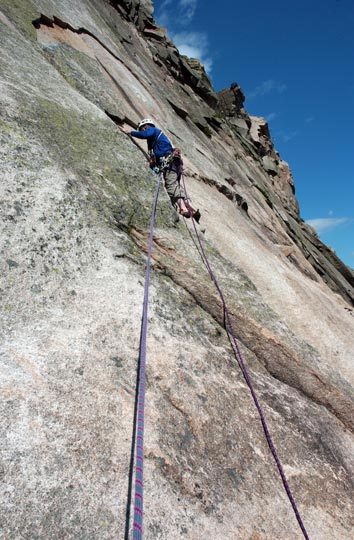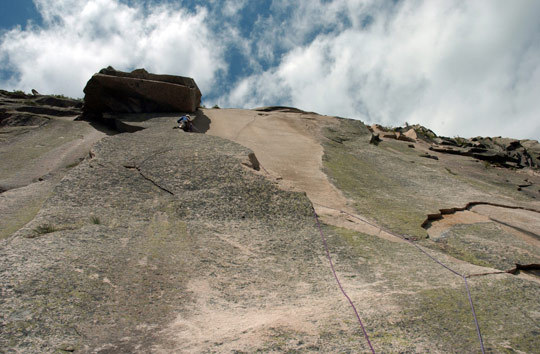Featured in Issue 21’s Crag Profile, Cannon Cliff, in New Hampshire’s Franconia Notch State Park, has a long history of interesting weather, thin ice and, most pertinently to this tale, constant rock fall. The granite that makes up the dome exfoliates with disturbing frequency. Cannon climbers know right from the get-go that every route they climb could be on the ground tomorrow. Climbers either resign themselves to that fact, or stop climbing at Cannon. Sometimes, however, simple exfoliation cannot describe the situation. Jon Sykes tells his story of the ever-changing nature of Cannon climbing.

Jon Sykes beginning the first pitch of the new route. It involves a poorly protected traverse across the face to gain a chimney and corner system. [Photo] Jamie Cunningham
During the wee hours of the morning on June 19, 1997, one of the largest rock slides ever recorded in the area swept down the wall of Cannon Cliff.
By the time it reached the talus slope below, the momentum generated by six hundred feet of free fall allowed the rock slide to grow to five hundred feet wide. The falling stone slammed into the ground with such force it could be read on seismographs nearby. The slide traveled nearly a half mile, and boulders larger than pick-up trucks snapped trees off the ground like twigs. Nothing was left at the base but a massive crater of pulverized granite dust. The slide’s momentum was so powerful that it continued down the talus slope below, entered the woods and careened through the forest, until the last massive boulder came to rest just a few feet from the bicycle path winding down through the Notch.
New Hampshire no longer experiences the traditional January thaw lasting a few weeks. Now, freeze and thaw cycles happen regularly throughout the winter, likely due to global warming, which leads to extensive expansion and contraction of the rocks at Cannon and other cliffs. The roof capping the final pitch of the classic climb, Whaleback Crack, cracked off of the granite dome and started the massive rock slide.
In October of 1972 the young, strong team of Bob Anderson and Henry Barber were seeking out some adventure on Cannon’s flanks. From the climber parking lot at Boise Rock, they stared up at the outline of a whales back, formed by a massive flake four hundred feet up the cliff. They were about to make a bit of New England history by climbing the first route to be rated 5.10 on Cannon Cliff. Ed Webster’s second edition of Rock Climbs in the White Mountains of New Hampshire would call Whaleback Crack, “5.10R; a notorious detached flake.” Ed was right. Anderson and Barber lead the two hundred plus foot route in three short pitches. The mental crux on the second pitch was a mandatory thirty foot unprotected lieback up the ever widening offwidth of the whale’s back. The third pitch climbed out from under a large roof formed by the very rock that sits beside the bike path today.
A month before the slide, Chris Marks and I set out to climb Whaleback Crack. We were stopped by a body size flake that teetered precariously above our rope at the beginning of the climb. Fearing the consequences, I climbed an adjacent route–Indigo (5.8)–which allowed my partner, Chris Marks, to test the safety of the flake. Not very safe, it turned out. The slightest touch of Chris’ hand, and the rock slid from its perch and soared to the talus below.
On June 8, 1997, two weeks, to the day, before the big slide, I found myself nervously climbing the diagonal approach pitches to the base of Whaleback Crack for the second time. Back at our shitty belay, we gazed up at the task before us. The ever widening corner loomed above me and I was decidedly unsure of myself. Chris sensed this and goaded me into action.
The start of the corner was pinched off and lichen made the climbing tenuous and slippery. My first piece of gear seemed a long way away. Seventy feet up the corner I noticed a small ledge and a lone pin a few feet to my right. It was probably the belay at the top of the first pitch from the original ascent. I found no comfort in clipping the pin and continued up the corner and into the runout lieback above. I had two #5 Camalots with me, hoping to take the sting out of the bad-dog crack. But my planning was to no avail. The flake was wider–much wider–than the cams.

Jon Sykes reaches the end of the 5.7 R runout to gain the corner and chimney system on the new, post-rockslide, Whale Watchers (5.9 R). [Photo] Jamie Cunningham
Chris shouted up words of encouragement. I replied by mumbling and whining unrecognizable words down the rope. More shouts and I started moving up again. Once I committed, I climbed quickly, finally slotting a piece after thirty feet of stout, sloping liebacks.
Above, I found the fateful roof and no comfortable belay so I kept climbing and finished the route in one long pitch. I crawled to the summit, exhausted, with rope drag pulling at my harness, ecstatic to have finished the climb. Chris followed quickly and we shook hands on top of Whaleback crack.
Chris and I had done–without knowing–the last ascent of Whaleback Crack, which made our climb even more bittersweet.
One week after the massive slide, the final flake that outlined the whales back, took leave of the cliff, ending a bit of Cannon history.
I returned to the cliff on September 21,1997 with two friends. We found ourselves mesmerized by the sight of what used to be Whaleback Crack. It was now an open scar of rock. A right facing corner system replaced the detached flake that used to be Whaleback Crack.
Unwittingly, Gareth Slattery and Mike “Bubba” Lee had volunteered to participate in one of the scariest first ascents I’ve ever led. Though they were not strangers to adventure and danger, having spent many a winter day poaching avalanche chutes and dropping into steep, never before skied brook-beds, the experience we had quelled their thirst for adventure like skiing had never had. We would all be humble with fear until the job was done.
Due to the loose nature of the four hundred foot rock face below what had been Whaleback Crack, we climbed the three pitches of Wiessner’s Dike to the Alpine Gardens and then diagonaled left for four hundred feet into the path of the rockfall–what is now known as The Zone. Even three months after the slide, crumbling granite dust covered every nook and cranny, loose rocks and massive boulders perched on piles of dust were waiting to crush us. We prayed to whatever god that might listen as we passed the sleeping devils of stone.
Finally, we reached the base of the climb proper. We’re stood below an hourglass shaped mass of granite. The upper two thirds was much larger than the rest and rested on the bottleneck no wider than three feet and about two feet thick. The bottom of the hourglass where we stood was only ten feet wide and a few feet thick. We felt so tiny and so fragile in this spot that we almost gave up. But, thinking of how much effort it took to get here, I decided to have a look see.
I climbed up and right on the face of the hourglass to reach the arching corner. Runout 5.7R took me up the arch to where I could place a knifeblade into a pinched-off corner. All the while my hands and feet were constantly brushing and cleaning the insidious, pulverized dust off holds.The corner eventually turned into a flaring chimney–the 5.9 crux–and then became the most enjoyable 5.8 chimney one could imagine. Finally, I topped out on the open slab above the hourglass where I placed two bolts. After bringing up my two friends, we groped our way to the top through junipers and loose rock to stand on top of the Old Man–once an icon of New Hampshire, found on our coins, now victim to its own 2003 rockfall.
Fast Freddie Wilkinson and I did a four-pitch direct start up the middle of the Zone a few years later which we called The Whalers (5.9R), which gave Freddie the dubious honor of leading the second known ascent of Whalewatchers.
Was he nervous? Well let’s just say that he was questioning whether or not I was sandbagging him at the crux, “a couple of times.”
Do you dare?
Jon Sykes is the resident authority and aficionado of Cannon Cliff and climbing in the Western White Mountains of New Hampshire. In 2001 he published his well received–and now out of print–guide book to Franconia Notch: Secrets of the Notch. He has climbed most of the routes on the Grand Old Cliff, including the popular, obscure and terrifying. Through his explorations he created eleven new routes of his own. He continues his explorations of Cannon to this day at 49 years of age. Jon is one of the most driven, colorful, charismatic, and sometimes cantankerous climbers to every grace the sides of the Old Lady! He is a true Cannon “swamp donkey” local.
Jon is currently co-authoring a new guide book to the Western White Mountains with photographer Jamie Cunningham. The book is due to be on book shelves in two years. Visit www.thenotches.com for more information.

Jon Sykes heads into the off-width chimney on the upper reaches of Whale Watchers, (5.9 R). The lightly colored stone to the right of Sykes is the site of the original Whale Crack.